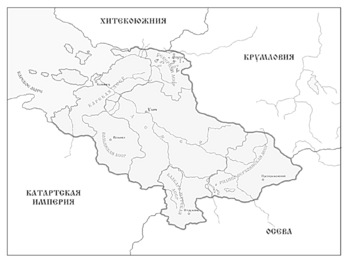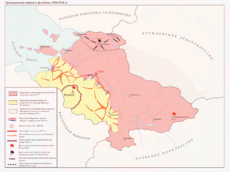Dulebian Federative Socialist Republic: Difference between revisions
The ©rusader (talk | contribs) |
The ©rusader (talk | contribs) m (The ©rusader moved page Dulebian Socialist Federative Republic to Dulebian Federative Socialist Republic: Dulebian Federative Socialist Republic) |
(No difference)
| |
Revision as of 03:17, 28 January 2020
Dulebian Federative Socialist Republic Дулебская Федеративная Социалистическая Республика Dulebskaya Federativnaya Sotsialisticheskaya Respublika | |||||||||||
|---|---|---|---|---|---|---|---|---|---|---|---|
| 17 January 1914 - 12 April 1919 | |||||||||||
| Anthem: Дулебянка Dulebyanka | |||||||||||
 Territory of the Dulebian Federative Socialist Republic in 1919, after the Dulebian Civil War | |||||||||||
| Capital | Ulich | ||||||||||
| Common languages | Dulebian | ||||||||||
| Government | Federal Marxist–Leninist one-party socialist republic | ||||||||||
| Head of state | |||||||||||
• January 1914 - April 1919 | Viktor Shchyukin | ||||||||||
| Legislature | Supreme Workers Assembly | ||||||||||
| Historical era | Continental war | ||||||||||
| 1913-1918 | |||||||||||
• Republic proclaimed | 17 January 1914 | ||||||||||
| April 1919 | |||||||||||
| Currency | Dulebian mark | ||||||||||
| |||||||||||
The Dulebian Federative Socialist Republic (dul. Дулебская Федеративная Социалистическая Республика, tr. Dulebskaya Federativnaya Sotsialisticheskaya Respublika) was a short-lived state proclaimed in 1913 following the January Revolution in the Dulebian Empire and the dethronement of emperor Aleksandr III. It de jure controlled the territory of the former Dulebian Empire during its participation in the Continental war. Its borders were set in May 1914 following the Treaty of Ulich with Krumlau and the formal defeat in the continental war.
The state was a personal project of Viktor Shchyukin, who believed that the only way to keep the Dulebian state stable after the worker's revolution was to make it federative and give its ethnic minorities a decree of autonomy. During the opening stages of the civil war most high-ranked officials tended to agree with Shchyukin's plan. However, as the war progressed, it became clear that once the fight is over, giving autonomy to the minorities, especially in the south of the country, would destabilize the country and higher the risks of foreign intervention and a new civil war. On the secret meeting of the Worker's Soviet in June 1916 it was agreed that the federative republic, headed by Shchyukin, would be preserved only until the end of the armed conflict, as the rebellous southern republics still were very valuable allies against the Royalists. According to the agreement, once the civil war was over Shchyukin would have been removed from his post by all means and marshall Konev would take his post, dissolving the federative structure and establishing an unitary state while dealing with any opposition within the country.
The Dulebian civil war officially ended on 5 November 1918. In December 1918, a group of commissars led by Konev offered Shchyukin to leave his post at his own will and hand all power to Konev, to which he refused. Three months later, in April 1919, Shchyukin died in mysterious circumstances, "killed by a Krumlauvinan spy" according to the Dulebian version, in reality most probably poisoned by Konev during a banquet of high-ranked officials. In the following days all power was handed to Konev, who officially dissolved the federation on 12 April 1919, beginning a series of political reforms and repressions known in Dulebian history as Konev's Reformation.


